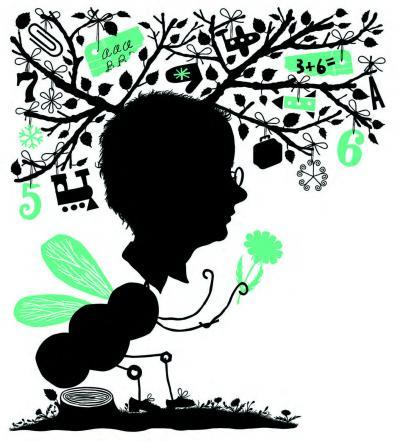Preschool ADHD Study

Written by Thomas W. Durso | Illustrations by Melinda Beck
A new, groundbreaking study shows that a series of innovative behavioral interventions can give preschool children a new perspective on life in —and out of— the classroom.
Walk into most preschool classrooms in America, and you cross into a world of organized chaos—a furry of running children, colorful walls and undecipherable noise. But even among all the loose energy, you can’t help but spy your child’s four-year-old classmate bouncing of the walls. He seems not to be paying attention most of the time, and needs to be told something three or four times before he does what is asked. You have a chuckle with the other moms and dads who are seeing what you see because, chances are, it’s all part of the daily routine. It's also a scenario that could prove to have strikingly negative consequences in the years to come.
Perhaps that four-year-old is a boy with nervous energy. Or maybe he’s afflicted with Attention Deficit Hyperactive Disorder (ADHD), a lifelong and incurable disorder that affects nearly one in 10 school-age children. “That kid is at risk 10 or 15 years down the road of dropping out of school, then perhaps not getting as good a job as he might have and maybe not being able to hold a job,” says Lehigh’s George DuPaul, professor of school psychology and chair of the department of education and human services. “At an even greater extreme, he’s at an increased risk of being arrested and incarcerated. That cost to society is pretty great.”
Surprisingly, there’s a good chance every preschool parent may know a child with ADHD. Estimates show that, in every preschool room, there’s at least one child with the disorder. Nearly 40 percent of children who show signs of ADHD are suspended from preschool. Sixteen percent are eventually expelled. "Researchers have calculated the economic impact of ADHD as billions of dollars in terms of treatment and lost resources and opportunities," DuPaul notes.
A New Benchmark
Those suffering from ADHD at such a young age can find solace in a new groundbreaking study conducted by Dupaul and Lehigh colleague Lee Kern, the Iacocca professor of special education. Seeking to assess ADHD intervention techniques among children, the researchers led a five-year study that tracked the progress of 135 three-to-five-year-olds with symptoms of the disorder.
While ADHD is typically treated with medication at that age, DuPaul and Kern concluded that non-pharmaceutical interventions are an effective way to treat the disorder.
The results were significant. Using a variety of early-intervention strategies, parents reported, on average, a 17 percent decrease in aggression and 21 percent improvement in their children’s social skills. Teachers saw similarly strong results; in the classroom, there was a 28 percent improvement in both categories. Early literacy skills improved up to three times their baseline status.
Eddie Fitzgerald, a rambunctious preschooler, was one of the study’s participants. Soon after turning three, his parents and teachers noticed a growing number of temper tantrums and disruptive activities—tossing toys, throwing things of bookshelves—that escalated into bigger problems.
Eddie’s outbursts weren’t relegated to the classroom, though. He could have just as easily been angered or distracted by something that happened while playing on his swing set, and trips to the grocery store became unbearable for Eddie’s parents. He also struggled to sustain friendships.
“We were always fighting with him,” his mother, Sheree Fitzgerald, told The Morning Call newspaper. “I was at my wit’s end. It was not a lot of fun.”
But working together, Eddie and his parents learned to control and overcome his ADHD symptoms by using a variety of positive behavioral techniques promoted by DuPaul and Kern. They used a kitchen timer to let Eddie know when to transition to a new activity, for example, and used role playing and positive reinforcement to encourage Eddie to follow directions.
Three years later, the high-energy youngster was little different from his classmates, according to an Associated Press story. In fact, school psychologists in his elementary school wouldn’t have diagnosed him with ADHD.
Leading Indicators
The interventions implemented and assessed by DuPaul and Kern included highly individualized programs, usually involving behavior analytic procedures that often relied on positive reinforcement. For example, in consultation with parents and preschool teachers, researchers modified the environments in the home and at school, such as altering tasks and activities in the classroom to accommodate ADHD students. Another intervention was token reinforcement, in which tokens were distributed for positive behaviors and could be exchanged later for some sort of reward.
“We found that there are a number of behavioral and academic strategies that are effective above and beyond what medication might add to the equation,”DuPaul says. “In particular, if we intervene early with young kids who appear to be at risk for this disorder, we can reduce the need for medication and also perhaps use less intensive strategies than with older kids. The earlier, the better: It’s going to cost us less in terms of resources and involve less use of medication.”
From a researcher’s point of view, DuPaul and Kern’s work is valuable in providing empirical evidence for the value of psychosocial interventions. But from a clinician’s point of view, the strength of the work lies in its positive outcomes. John Van Brakle, chair of the department of pediatrics at Lehigh Valley Hospital, who assisted the Lehigh team, notes that the study revealed improvement in three areas—in the children’s behavior, in their parents’ ability to work with them, and in school readiness.
 As part of this early intervention project, study participants were divided into two groups. Parents of children in the first group were given general guidance on how to interact with—and better understand—their kids, and how to deal with behaviors they were concerned about.
As part of this early intervention project, study participants were divided into two groups. Parents of children in the first group were given general guidance on how to interact with—and better understand—their kids, and how to deal with behaviors they were concerned about.
Parents of children in the second group received more intensive, one-on-one engagement with the researchers to develop truly individualized intervention techniques.
Both groups of children showed improvement, and at about the same rate—a surprise to the researchers, who expected the kids receiving greater attention to improve more. Van Brakle says that further investigations are needed to determine how these intervention techniques play out over the long haul. Often, he says, such longitudinal work provides evidence of even more positive results, especially for those in the high-attention group.
“In a lot of behavioral studies in younger children, if you measure things a year out, the level of improvement is not as obvious as if you look at things several years down the line,” Van Brakle says. “It’s possible that if you look at these two interventions three years after the study, the group with a much higher intervention level may have improved outcomes.”
The multiyear study, published in School Psychology Review and funded by the national Institute of Mental Health, was one of the first to examine the use of a comprehensive, non-medicinal early-intervention program for young children with ADHD. That alone rendered the work significant, according to experts.
“To date, there have been very few large-scale, systematic studies of the effectiveness of academic and behavioral interventions in school settings. Their research fills an important gap,” says Tomas J. Power, editor of School Psychology Review and program director with the Center for Management of ADHD at Children’s Hospital of Philadelphia. “It is noteworthy that a high percentage of the students participating in their study received psychosocial intervention without pharmacological treatment, highlighting the potential for non-medicinal interventions to contribute to important changes in child development.”
DuPaul points out that the nature of ADHD makes early—and effective—intervention crucial in order to ameliorate the costly troubles those who suffer from the disorder often encounter later in life.
“We’re not curing kids; this is a chronic problem,” says DuPaul. “Similar to diabetes, this is a lifelong treatment plan you have to look at.”